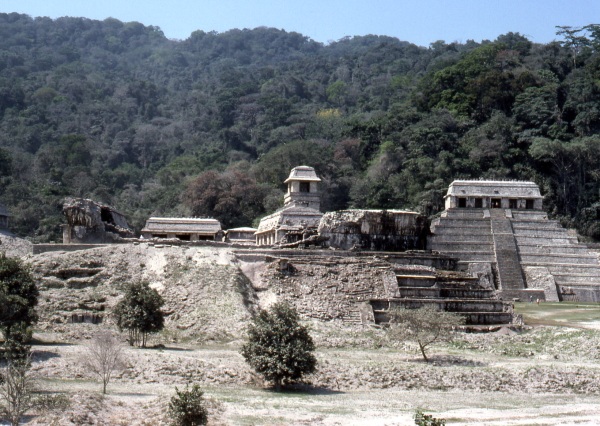Not all volcanoes give any warning of impending activity. Exactly thirty years ago, just before midnight 28/29 March 1982, the El Chichón volcano in Chiapas erupted completely without warning and with unexpected fury. Two further eruptions followed in early April. The lack of warning caused heavy loss of life among local villagers who had been unable to evacuate their villages. About 2,000 people lost their lives as a result of the eruption.

Palenque covered in ash following the eruption of El Chichón. Photo: Tony Burton; all rights reserved.
Ash from El Chichón fell over a wide area of southern Mexico. The nearby Mayan archaeological site of Palenque (set on the edge of what is normally a luxuriant, tropical-green jungle) was covered in ash (see photo above).
Concerned about the potential for the ash to combine with rainfall and form an acidic solution that might erase delicate and intricately carved stones, workers at the site engaged in a major clean up, even before all the ash had stopped falling. The second photo (below) shows a worker on top of one of Palenque’s distinctive roof combs sweeping the recently-fallen ash off the structure.

Sweeping ash off Palenque following the eruption of El Chichón. Photo: Tony Burton; all rights reserved.
Vulcanologists later worked out that the last previous eruption of El Chichón had been 1200 years earlier. The eruption “left behind a brooding, sulfuric, acidic lake that formed when the dome collapsed into a crater and filled with water.”
El Chichón forced more than 7 million tons of sulfur dioxide and 20 million tons of particulate material into the stratosphere. The resultant cloud of volcanic gases circled the Earth in three weeks and was still dissipating three years later. It was expected that the additional particulates in the atmosphere would reduce the solar radiation reaching the earth and cause the following summer to be cooler than usual. However, in an unlikely coincidence, an El Niño event began that same year, negating any significant cooling effect from the volcano’s particulates.
The El Chichón eruption was one of the largest volcanic eruptions of the 20th century, exceeded only by the 1991 Mt. Pinatubo eruption in the Philippines in terms of the amount of volcanic gases and particulates entering the stratosphere. Ash fell over a wide area, from Campeche to San Cristóbal de las Casas in Chiapas.
By the time the eruption was over, the volcano, whose summit had been 1260 m (4134 ft) prior to the eruption, had lost 200 m in height. The Chiapanecan Volcanic Arc, which includes El Chichón, falls outside Mexico’s Volcanic Axis (the location of almost all Mexico’s volcanoes) and is thought to be related to the subduction of the edge of the Cocos Plate underneath the North American plate.
Related posts:

Sorry, the comment form is closed at this time.